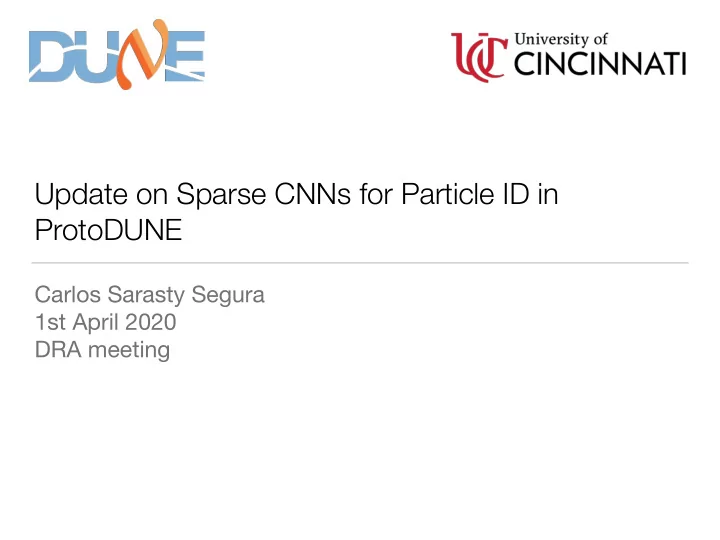

Update on Sparse CNNs for Particle ID in ProtoDUNE Carlos Sarasty Segura 1st April 2020 DRA meeting
Outline • Definition of the ground truth • Training using 2D samples • Training using 3D samples • Summary 2
Semantic Segmentation • Goal: Apply sparse CNNs for the task of semantic segmentation at a pixel level in ProtoDUNE Time tick Wire Id 3
Ground Truth - First Version • Classify each pixel into 7 different classes for supervised learning • MIP → Two classes → muons & pions • HIP → Protons, kaons & nuclei • Showers → Induced by electromagnetic particles such as e - and e + • Michel electrons → From the decay of muons • Electromagnetic activity → Electrons from hard scattering, and low energy e - • Neutrons • Record the fraction of energy deposited by each class per pixel https://indico.fnal.gov/event/20144/session/17/contribution/93/material/slides/0.pdf • 4
Supervised Learning The dataset consist of about 100.000 2D image samples of up • to 6000 px split into 95% and 5% for train and test respectively 1 feature → Integrated cargu e • 5
Event Display Example True Predicted Time tick Wire Id 6
Muon-Pion Separation ROC curve 7
Moving to 3D • Ground truth: • Modify the ground truth definition to separate kaons from the hip class. • Merge neutrons & EM activity into 1 class • Features: • Increase the number of features from 1 to 7 (3 coordinates per hit, integrated charge per plane per voxel, number of hits per voxel) • Issues: • Low statistics for the kaon class → only 5% of files contain kaons 8
Supervised Learning • The dataset with kaons consist of 3943 3D images split into 95% and 5% for train and test 9
Muon-Pion Separation ROC curve 10
Second case • Ground truth: • Merge kaons back in with protons into hip class • Dataset: Consist of 70k 3D images 11
Muon-Pion Separation ROC curve 12
Event display - True 13
Event display - Predicted 14
TO DO: • Modify the ground truth: • Include Delta rays as a separate class. • Separate electron and photon showers • Retrain and test the model for electron and photon separation. 15
Summary • We have trained the network using different definitions of the ground truth and different datasets • The performance of the network using 3D samples is significantly better than the 2D case • A training using kaons as a separate class can be possible with a bigger dataset • Comments and suggestions are more than welcome • Thanks! :) 16
Backup slides 17
Ground Truth The first approach to distinguish the different classes of particles is • based on the pdg and track Id information • Geant4 also provides valuable information of the physical process of a simulated particle and its parent. This information is useful to characterize Michel electrons • Non-primary electron • Electron’s parent is a muon • Same with positrons. • Neutrons • Check the process → n-capture , neutron Inelastic scattering 18
Ground Truth • EM showers and EM activity • In the MC Truth the information of secondary and tertiary particles from showers is thrown away → shower daughters are tagged with the negative track ID of the parent particle • Identify all particles that belong to the same track ID • Set a threshold in the number of hits → nhits > 10 ~ 5cm • Any other e +/- will be labeled as EM activity 19
Ground Truth Drift Volume 1 20
Ground Truth Event display - True 21
Recommend
More recommend